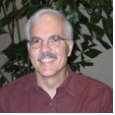In his first west coast appearance, the IBM Watson creator gave a talk at the Computer History Museum in Mountain View, CA, followed by an exhibition Jeopardy! match between Watson and two brave volunteers with comedic host, IBMer Eric Brown.
 |
| Computer History Museum president John Hollar |
"At our house, I'd always call the kids down to see something 'interesting' that I'd done - some type of experiment or science-related thing," Dave said. "After enough of these demonstrations, my daughter started to associate the word 'interesting' with 'boring' - so there's a little about language context."
 |
| IBM Watson principle investigator David Ferrucci (left) with Financial Times' Richard Waters |
After obtaining his BS in biology from Manhattan College, he pursued computer science with an emphasis in knowledge representation and reasoning at Renesslaer Polytechnic Institute, completing his Ph.D. in 1994.
Since joining IBM in 1995, Dave has contributed largely to the Research function as a computer scientist. But in 2007, when IBM executive Charles Lickel challenged Dave and his team to revolutionize Deep QA and put an IBM computer against Jeopardy!'s human champions, he was off to the races.
"I had to get funding," Dave explains. "I told the executives I could do this in 3-5 years. I kind of just guessed."
The executives bought it, and Dave had a huge task ahead. By assembling a team of eventually 28 researchers in the areas of natural language processing, software architecture, information retrieval, machine learning and knowledge representation and reasoning, Dave created Watson - a computer system, that, using a combination of sophisticated hardware and software, could understand natural language and deliver a single, precise answer with confidence and evidence for its decision.
At the end of the conversation, Dave told the crowd about Watson's new job in the medical field: "We want Watson to enable better judgement by humans in decision-making, whether it be in medicine, law, finance or services," Dave said. "While the human is the ultimate decision-maker, Watson will provide evidence and confidence by scouring millions of sources of related information in a short amount of time."
 |
| GigaOm's Stacey Higginbotham takes on IBM's Watson and Sierra Ventures' Robert Walker in an exhibition match |
In an exhibition Jeopardy! game following the talk, IBM's Eric Brown played host to GigaOm's Stacey Higginbotham, Sierra Ventures' Robert Walker, and "oh yeah, our third contestant, Watson, from Yorktown Heights, New York, built by a few computer scientists," an introduction met with laughter that would continue throughout the game.
 |
| The humans playfully 'teamed' up against the computer, high-fiving and fist bumping on each correct answer |
The night continued in that way, and the human contestants even found themselves getting answers from the crowd, to which host Eric Brown responded: "Watson can't hear you, so humans have an advantage!" As it turned out, the trick was buzzing in before Watson - hard to do unless you're a seasoned Jeopardy! vet like Ken Jennings or Brad Rutter.
As the exciting match wound down, and all three contestants answered the Final Jeopardy! question correctly, Watson came away with the win, but left the auditorium with tremendous enthusiasm for this computer and its impact on the future of technology.
Check back here for a video clip of this event and the IBM Research news blog for more news about Watson.
More from the event:
*apologies for the incorrect orientation





